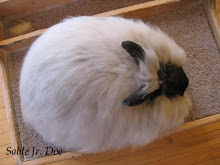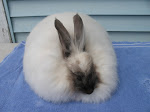After a few years of rabbit raising most people have figured out that grooming angoras is easier in certain types of weather than others. Of course, standing out in the rain blowing wool is impossible under any circumstances and should never be attempted (LOL), but it is definitely true that wool responds differently according to how much humidity is in the air, what the air temperature is, and many other factors.
When it is extremely humid out, wool tends to be limp and clumpy with very little 'body' to it. Like human hair, it also tends to snag more easily, making it harder to groom with the brush or comb without pulling unwanted fiber out. On days such as this, grooming should either be avoided altogether or the use of a brush or comb should be avoided and the blower should be the only thing used in it's place. Since clumping normally begins at the skin, the blower is the best tool for eliminating webbing, getting down to the base of the coat and working the tangles out from the inside up.
On cool, dry days there is usually the opposite problem to deal with from what occurs when it is damp. On days like this there is often static electricity in the wool, and it is nearly impossible to get the coat to lay properly in many cases, eliminating drape entirely on breeds like the SA and FA. The other problem with lack of humidity in the air is that it is easy to break fibers when they are in 'flyaway' mode by brushing or combing them, but the blower is not much better for days like this since it can make the problem worse also:(. The solution that many breeders employ to combat dry wool is to keep a spray bottle nearby and 'mist' the air directly above the rabbit as it sits on the grooming table. This lends enough moisture to the wool to enable you to groom it, but it does not add so much that the coat gets wet and becomes matted. Another solution that I have heard of to tame flyaway coats is to unscrew the back of the blower and insert a dryer sheet over the filter to diminish static electricity. Different methods can be used to fix these kinds of problems and each breeder has to decide for him/herself what will work in their particular climate.
Temperature can also have a dramatic impact on the quality and growth rate of an angora coat. In my area of the Northeast the wool quality is worst in the summertime, when heat and humidity work together to slow wool growth and make the resulting coat thinner and less even. Pregnancy and nursing will also take their toll on a doe's coat, impeding growth and density and often condition, especially in extreme weather when a doe is using all her resources to raise a litter in the heat or cold.
The best angora coats in my experience are those that have been grown in the depths of winter on does who have not been bred and who are eating and drinking well and regularly. Intensity of color also improves dramatically at this time of year making the overall effect even more impressive, but wool grows faster and holds longer in the winter as a general rule, and that is when we can expect our rabbits to be at their absolute peak in wool quality and production.
More next week as we wait for the rest of the snow to melt here (and the flood waters to go down) and hope for a beautiful Spring right around the corner:). I have several litters due next Wednesday though only 2 out of the 4 does are showing signs of nesting yet. A few weeks later there will be 2-3 more girls to kindle, and then I will breed another bunch again to launch the spring breeding season.
Have a wonderful and DRY week:-)
Sunday, March 9, 2008
Subscribe to:
Post Comments (Atom)























No comments:
Post a Comment